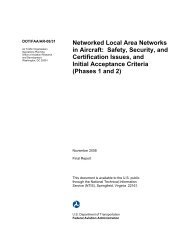Published Report (DOT/FAA/CT-94-36)
Published Report (DOT/FAA/CT-94-36)
Published Report (DOT/FAA/CT-94-36)
Create successful ePaper yourself
Turn your PDF publications into a flip-book with our unique Google optimized e-Paper software.
sometimes instructed to disregard controller communications,<br />
thereby not correcting the blunder. A blunder with this<br />
condition will be referred to as a ttno-responsett blunder in this<br />
report.<br />
2.1.3.1 Blunder Scripts.<br />
Blunder scripts were developed from the traffic samples to assist<br />
the test director with creating potential TCV's. All blunders<br />
were initiated by TGF aircraft and occurred after vertical<br />
separation had been lost with aircraft on an adjacent approach.<br />
Sixty percent of the blunders were scripted to occur between the<br />
17L and 17R runways, with the remaining 40 percent occurring<br />
between runways 17R and 16.<br />
Eighty percent of the blunders were scripted to be 30-degree<br />
turns off of the localizer, 17 percent were scripted to be 20-<br />
degree turns, and 3 percent of the blunders were scripted to be<br />
10-degree turns. In order to simulate worst case scenarios, 70<br />
percent of the blunders were scripted as no-response blunders.<br />
Only 30 degree, no-response blunders initiated into flight<br />
simulator targets were assessed in the statistical evaluation of<br />
the data. In previous simulations, controllers have been able to<br />
resolve 10 and 20-degree turns, and these blunders only<br />
contributed to about 1 percent of the total risk.<br />
2.1.3.2 Closest Point of Approach (CPA) Prediction Tool.<br />
The CPA Prediction Tool is a software tool used by the test<br />
director in creating potential TCV's. The software presented the<br />
call signs of the blundering and the evading aircraft in a window<br />
on the test director's display. For each aircraft pair, the CPA<br />
Prediction Tool used aircraft velocities, headings, and blunder<br />
degree in the real-time calculation of a predicted CPA. The time<br />
until the CPA would be reached, given an immediate execution of<br />
the blunder, was also calculated. This information was updated<br />
with each radar update, every 4.8 seconds, and was presented with<br />
the aircraft call signs.<br />
The window had the capacity to accommodate four aircraft pairs at<br />
one time. The aircraft pairs which appeared in the window were<br />
determined by the scripted blunder scenarios; however, the test<br />
director had the capability to create blunders that were not<br />
designated on the blunder scripts. The test director also had<br />
the capability to delete aircraft pairs from the window.<br />
2.1.4 Traffic Samples.<br />
The traffic samples were based on actual arrival traffic into<br />
Denver-Stapleton Airport. Each of the samples was composed of a<br />
representative population of propeller-driven, turboprop, and<br />
8

















